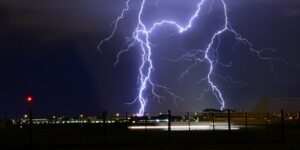Floods are important shapers of the world around us. Storms and floods can be so powerful they can dramatically alter the appearance and behaviour of rivers and valleys in just a few hours. These changes are larger than all the changes over decades beforehand.
Dr Chris Skinner leads the SeriousGeoGames Lab. His research is in the field of geomorphology, a science that seeks to understand how landscapes got be how they are and the processes that shaped them. He uses computer models to simulate these processes, for example the erosion and deposition of sediments by river, to understand how floods can change river valleys and how these changes can alter the risk of flooding in areas.
Flash Flood! is a virtual reality activity used at events and festivals to show people what flash flooding looks like and how damaging it can be to river valleys. It was made using real research data collected from the Thinhope Burn catchment, part of the South Tyne system, before and after a real flood that happened in 2007. That flood changed the appearance and behaviour of the river valley in just a few hours – Flash Flood! recreates this in the safety of a virtual environment. You can get a taste of what the Flash Flood! experience is like in the 360 video version below. For the best experience access the video via the YouTube App on a smartphone. As this is a 360 video, you can drag your mouse or move your device to change your view. If you have a cardboard virtual reality headset this will give you the full Virtual Reality experience!
Flash floods are rare but potentially devastating. They most often occur in the summer when warm, moist air rises to form thunderstorms. These storms are short-lived, and only cover a small area, but the rain can be very intense. If this deluge of water happens to fall on the upper reaches of a steep upland catchment, that water can be funnelled into narrow channels. The flash flood flows are powerful, picking up debris – trees, mud, rocks, anything in their way – becoming unstoppable and bulldozing their way down river valleys and destroying anything in their path.

Thunderstorms are difficult to forecast in detail – always stay alert when in an area with warnings for thunderstorms (Image from The Met Office)
The storms that cause flash flooding are difficult to forecast accurately. Meteorologists can forecast the conditions where thunderstorms form but the computer models do not yet have the detail to tell us exactly when and where the storms might occur. If you are in an area where thunderstorms are forecast as likely, you should remain vigilant.
Extreme events, like flash floods, are important shapers of our environments and are able to make dramatic changes in short spaces of time. Often more change than has happened in many decades before the event. They disrupt landscapes, loosening up material, and making them more susceptible to change. It can take many years for them to return to normal. Climate change is adding more energy and moisture into the air and this will make extreme events even more extreme and more likely to happen. Our landscapes will become more dynamic as a result.